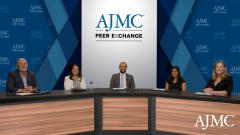
Managing Patients with CDK 4/6 Inhibitor-Resistance
Dr Hanna drives a discussion regarding breast cancer treatments that have developed resistance to CDK 4/6 inhibitors.
Episodes in this series

Kirollos S. Hanna, PharmD, BCPS, BCOP, FACCC: Let’s say a patient wasn’t compliant now or they were compliant but unfortunately their disease has developed some type of resistance to CDK [cyclin-dependent kinases] 4/6. Walk me through that, Sam, what does resistance look like to CDK4/6s? What implications does that have in the event that this patient now has metastatic disease or if there’s any data around utilizing CDK4/6 for the finite period of time in that adjuvant setting and then now they have metastatic disease? What does that look like in terms of this pathway?
Samyukta Mullangi, MD, MBA: I’ll maybe start with the metastatic setting just because we see that more commonly there. A CDK4/6 inhibitor plus an endocrine therapy is our first-line approach for hormone receptor–positive, metastatic breast cancer. And there you see that the median progression-free survival [PFS] is about 24 months, plus or minus. And that’s to be expected to some degree with any kind of therapy. So as CDK4/6 inhibitors are doing their antitumor thing, you’re going to have pathway signaling changes around RB [retinoblastoma protein] loss or CDK4 amplification and inevitably you’ll have some degree of CDK4/6 inhibitor resistance. Last year at ASCO [the American Society of Clinical Oncology Annual Meeting], we heard from Kevin Kalinsky’s group with the MAINTAIN trial [NCT02632045] suggesting that one could switch patients who had progressed on a first-line CDK4/6 inhibitor to ribociclib plus a different endocrine therapy, either fulvestrant or exemestane and continue to receive some degree of PFS benefit, maybe 4 or 5 months. And then more recently now we have data around capivasertib and fulvestrant suggesting a doubling of PFS. So maybe once that achieves FDA approval that becomes a new standard of care in the second-line setting there.
Kirollos S. Hanna, PharmD, BCPS, BCOP, FACCC: It’s exciting to see targeted therapies where you can maintain some responses. I know we’re seeing this across various cancers and your tyrosine kinase inhibitors [TKIs] even, that kind of sequencing or something. I think even in the BTK [Bruton tyrosine kinase] space pirtobrutinib was approved following standard progression on a standard BTK inhibitor. So it’s exciting to still see that trajectory in the CDK4/6. Talking now a little bit more or delving more in depth in terms of pathways, finances, and everything in this space, Sarah [Sammons], I’ll come to you. In terms of the financial burden with CDK4/6s, what kind of patient support is there? Whether it is grants or foundations from our pharmacy partners, do you find that with one CDK4/6 inhibitor, you’ve found better support or easier to navigate that financial round for your patients?
Sarah Sammons, MD: That’s a good question. And there’s a whole field of research now that we call financial toxicity of cancer care. It really does become a burden for patients to manage these copays, manage being off work, to make their appointments. There’s a new entity that I heard called time toxicity, which is the amount of time that you have to take off work to make it to the clinic. And that’s something that we have to think about, especially in prescribing these adjuvant medications. I have to say, we have a team that works with oral medication prescribing…I write the prescription and they really take it from there. They fill it, they do the prior authorization, they figure out which pharmacy the patient’s insurance is going to cover, and they navigate the patient assistance for the patient, which is inevitably needed for the vast majority of patients. On average, a month of abemaciclib is about $15,000. And that’s the same for the other CDK4/6 inhibitors. It is a problem but I do find, though it can take time, I think the major issue in prescribing is the time that I write, if the payer needs to apply for patient assistance, that can take a matter of weeks. But I have rarely to never had a patient that couldn’t get the medication that needed it based on patient assistance programs, vouchers, and things like that.
Kirollos S. Hanna, PharmD, BCPS, BCOP, FACCC: We have similar pharmacy personnel in place. I would say you’ll find that pretty standard across most cancer institutions now—the navigation of this financial realm, looking at your grants and your foundations and your copay assistance. We developed a tracker to see how much monetary value some of our financial navigators can bring to our patients and you look at it year after year. You’ve seen oral oncology continue to expand and everybody has their support programs, but just seeing that monetary value increase year after year that they’re bringing into our patients also makes it very easy for FTE [full-time equivalent] justification. I just told my clinic to look at the growth of our oral oncolytics. We need 2 more FTEs to help support these clinics because just the dispensing of all these has continued to rise.
Sarah Sammons, MD: It also just speaks to the amount of workforce that it takes to navigate cancer care, in prescribing an oral medication that goes to a pharmacist who does the prior authorization, the nurse navigator, who does the oral teaching, someone else who’s submitting all the paperwork to the insurance company. That’s 4 people working behind the scenes to get this patient oral medication. And that is genuinely what it takes nowadays for cancer care and that’s the intangible costs that I don’t think we talk about.
Kirollos S. Hanna, PharmD, BCPS, BCOP, FACCC: It takes a village.
Transcript edited for clarity.
Newsletter
Stay ahead of policy, cost, and value—subscribe to AJMC for expert insights at the intersection of clinical care and health economics.

























































